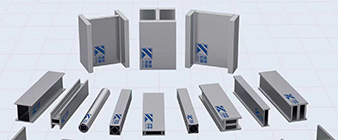There are several types of welding techniques and applications, including MIG, TIG, Stick, and Flux-Cored. We have many resources and articles discussing these welding processes. Today we will walk through the laser welding process, how the technique works, types of laser welding, its advantages, and application.
Laser (Light Amplification by Stimulated Emission of Radiation) welding is a fusion welding process where metals or thermoplastics are joined using a focused laser beam. It is the most advanced type of welding and finds application across diverse industries spanning from aerospace and medical equipment to fine jewelry making.
In the laser welding process, a highly concentrated beam of light is focused on the cavity between the materials to be joined. The powerful laser beam melts the materials at their seams and fuses into a joint. With such a highly concentrated heat source being used, laser welding in thin materials can be done at high speeds. In thicker materials, laser welding can produce deep and narrow welds.
In heat conduction welding, the laser beam heats the material surface above the melting point of the material. The process is used to produce welds that do not require high weld strength. This type of welding is done with a low power laser below 500W. Heat conduction welding produces smooth and aesthetical welds.
Keyhole weldingIn keyhole welding, the laser beam heats the material surface to the point of vaporization, penetrating deep into the material. This creates a keyhole with a plasma-like condition. The temperature rises above 10,000K. This type of welding is done with a high-power laser above 105W/mm2.
Laser welding is versatile and can be used in conjunction with arc welding to create hybrid laser arc welding. The resulting weld possesses the advantages of both laser welding and arc welding. The weld also has deep penetrating joints and improved tolerance to joint fit-up. Undesirable effects such as internal porosity and cracking are also reduced.
-
Less heat
A highly concentrated laser beam is focused on a small area, making the heat-affected zone (HAZ) smaller. Thus, laser welding operation requires low-temperature input when compared to traditional welding.
-
Faster processing time
Though the initial investment is high, the process proves to be more cost-effective than traditional welding. This is because laser welding has a faster processing speed that results in higher production and quicker turnaround.
-
Lowers risk of thermal distortion
There is less thermal stress because the process involves a low heat input. The focused beam melts only a small area of the metal, thus minimizing heat-induced internal stress and distortion to the workpiece.
-
High precision
The laser beam can be controlled and focused on a small area. This permits the welding of components with high precision. Its tailorable spot size makes laser welding most suitable for delicate or thin metals.
Due to its high precision, faster processing time, wide material tolerance, and consistent quality, laser welding has many applications.
Some of the areas where laser welding can be applied include:-
Automotive Industry
Laser welding offers a tool-free mode of operation and does not require the replacement of heads, making it extremely suitable for the automotive industry.
-
Steel Construction
Due to its high productivity and production, laser technology finds use in the steel construction industry. Laser welding makes it possible to process thick sheets of metals at high speed within high tolerance.
-
Shipbuilding
In shipbuilding, control and drive screws and rudders are manufactured with high precision and desired tolerance using laser welding. The result is lower fuel consumption and higher speeds for ships.
-
Tool Construction
High precision makes the laser welding system suitable for tool making. The technology provides a solution for the manufacturing of precise pressing, punching, and casting tools.
-
 2024-9-20 Application of Ti Gr 1 / 3.7025 structural beams and columns
2024-9-20 Application of Ti Gr 1 / 3.7025 structural beams and columns -
 2024-9-19 UNS N08904 stainless steel structural profile
2024-9-19 UNS N08904 stainless steel structural profile -
 2024-9-19 904L stainless steel structural Sections
2024-9-19 904L stainless steel structural Sections -
 2024-9-25 Introduction to 254SMO and UNS S31254 Super Stainless Steel
2024-9-25 Introduction to 254SMO and UNS S31254 Super Stainless Steel -
 2024-9-20 Application of Ti Gr 1 / 3.7025 structural profiles in nuclear power plants
2024-9-20 Application of Ti Gr 1 / 3.7025 structural profiles in nuclear power plants -
2024-9-25 EN standard 1.4404 stainless steel H-beam, channel steel, angle steel
-
 2024-9-20 Laser welding fabrication of Ti Gr 7/3.7235/UNS R52400
2024-9-20 Laser welding fabrication of Ti Gr 7/3.7235/UNS R52400



